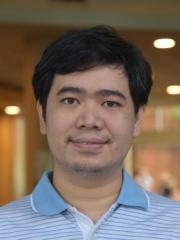
Shern specialises in theoretical and computational molecular dynamics for modelling of non-equilibrium systems and electrode-electrolyte interfaces.
Dr Shern Tee's research covers various methods for modelling complex, technologically-relevant systems at the molecular level using advanced molecular dynamics techniques, using the constant potential method and non-equilibrium dynamics. In the constant potential method, electrode atoms are given dynamically-varying charges, allowing electrodes to be charged or discharged in a computer simulation. This extends molecular dynamics to modelling complex electrophysical systems such as supercapacitors, capacitive desalinators and electrodes with nanoscale complexity. In non-equilibrium dynamics, we allow the fluids in our simulations to continuously flow, slide and shift, with potential applications ranging from nanofluidics to 3D-printing. Accurate non-equilibrium dynamics require careful accounting of the energy constantly entering and exiting a system so that simulations correspond accurately to real-world situations instead of computerized artifacts. Across all these applications, completing useful simulations demands accurate and efficient computer code, and Shern's research also covers developing and maintaining code for the open source software LAMMPS to enhance its capabilities.
Dr Shern Tee completed his Bachelor in Philosophy (Physics) at the Australian National University, writing his Honors thesis on modeling optical-trapping containers using the fluctuation theorems. After a stint teaching physics in Malaysia, he went on to complete his PhD at the National University of Singapore on coarse-grained modeling of biomimetic track-walking molecular motors built from DNA. He then moved to Australia and began his current postdoctoral position at the AIBN in 2018. Alongside his academic research, Shern is passionate about openness and collaboration in computational science, contributing to the annual Research Bazaar (ResBaz) Queensland as a Python instructor as well as the Turing Way and Research Software Engineering Australia-New Zealand online communities.
Collaborations
Dr Shern Tee actively collaborates with Prof. Robert Meißner at the Hamburg University of Technology on developing constant potential code for LAMMPS.
Funding
Dr Shern Tee has successfully applied for competitive computing resources grants with the Bernhardt Group, including the annual National Computational Merit Scheme and the Pawsey Centre for Extreme Scale Readiness program.
Key Publications
- ELECTRODE: An electrochemistry package for atomistic simulations, Ludwig JV Ahrens-Iwers, Mathijs Janssen, Shern R Tee, and Robert H Meißner, J. Chem. Phys. 157, 084801 (2022)
- Fully periodic, computationally efficient constant potential molecular dynamics simulations of ionic liquid supercapacitors, Shern R Tee and Debra J Searles, J. Chem. Phys. 156, 184101 (2022)
- Caveolin-1 and cavin1 act synergistically to generate a unique lipid environment in caveolae, Yong Zhou, Nicholas Ariotti, James Rae, Hong Liang, Vikas Tillu, Shern R Tee, Michele Bastiani, Adekunle T Bademosi, Brett M Collins, Frederic A Meunier, John F Hancock, Robert G Parton, J. Cell. Biol. 220 (3), e202005138 (2021)
- How Well Can DNA Rupture DNA? Shearing and Unzipping Forces inside DNA Nanostructures, Shern R Tee, Zhisong Wang, ACS Omega 3 (1), 292-301 (2018)
- Mechanosensing Potentials Gate Fuel Consumption in a Bipedal DNA Nanowalker, Shern R Tee, Xinpeng Hu, Iong Y Loh, Zhisong Wang, Physical Review Applied 9 (3), 034025 (2018)
| Featured projects | Duration |
|---|---|
| Computational Studies of Nanomaterials for Clean Energy Applications |

